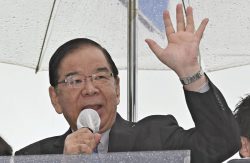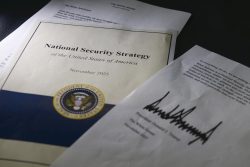16:43 JST, June 8, 2024
A former high-ranking officer of the Kagoshima prefectural police accused the prefectural police chief, who holds the highest position in the organization, of “covering up misconduct.” This is an extraordinary situation. The police should hurry to get to the bottom of the matter.
The prefectural police in May arrested Takashi Honda, the former head of the community safety department at the prefectural police headquarters on suspicion of leaking internal police documents to an outside third party.
During the disclosure procedure explaining the reason for his detention, held on June 5, Honda admitted to leaking the information and stated that he “could not tolerate the fact that Akiteru Nogawa, the prefectural police chief, had tried to cover up criminal acts committed by police officers.”
The community safety department head is one of the highest posts for noncareer-track officers, and is a position to support the prefectural police chief, who is a career-track officer from the National Police Agency. It is unprecedented for the department head to level accusations at the chief.
It is quite natural that National Public Safety Commission Chairperson Yoshifumi Matsumura stated at a press conference on June 7 that “clarifying the whole picture of the incidents is essential.” The confusion must be resolved as soon as possible.
The cases that Honda claims were covered up by Nogawa were both committed by active police officers. There was an incident of voyeuristic photography in a women’s restroom and a case of misuse of a “patrol communication book,” which compiles information collected from residents by the prefectural police.
The voyeurism incident occurred in December last year, and Honda said he, who was an active officer at that time, requested Nogawa to let him investigate. However, Honda claimed that Nogawa told him, “Let’s give him [the suspect] one last chance” and “Let him go and keep an eye on him,” and did not open an investigation immediately.
In the end, the officer on suspicion of taking the secret photographs was arrested in May after Honda reached retirement age in March this year and leaked the internal documents. It took five whole months to make the arrest.
The case of misuse of the patrol communication book, however, has not been disclosed in detail. There also was an incident of stalking by an active officer. Is there any connection between these two incidents?
The response of the prefectural police has been questionable on many points, which could lead to distrust by the people of the prefecture.
Nogawa on June 7 said, “I never gave any instructions with the intention of covering up,” but he is continuing to avoid explaining any details regarding the incidents. This cannot satisfy the people of the prefecture.
Another leakage of internal documents at the prefectural police came to light in October last year. This year, too, there was a case of a non-consensual sexual act committed by a police officer. There has been a total of four arrests, including Honda.
It is a deplorable situation for an organization that protects the safety of the people of the prefecture. The turmoil is deepening, and the prefectural police appears to have lost the capacity to investigate the situation as a concerned party.
Yasuhiro Tsuyuki, commissioner general of the National Police Agency, said, “We will conduct necessary inspections of the prefectural police.” The agency needs to take the lead in conducting interviews with the parties involved.
(From The Yomiuri Shimbun, June 8, 2024)
"Editorial & Columns" POPULAR ARTICLE
-

Artificial Intelligence Expands Possibilities for Foreign Language Learners
-

Build Intellectual, Physical Strength, As Well As Communicative Power / Japan Should Move from Beneficiary to Shaper of World Order
-

Global Economy in Turmoil: Prevent Free Trade System from Going Adrift / Risks to Financial Markets Must Be Heeded
-

Japan-China Strain Set to Persist as Beijing Officials Self-Interestedly Bash Tokyo; Takaichi Unlikely to Back Down
-

Elderly People Living Alone: What Should be Done to Ensure Living with Peace of Mind until the End?
JN ACCESS RANKING
-

Japan Govt Adopts Measures to Curb Mega Solar Power Plant Projects Amid Environmental Concerns
-

Core Inflation in Tokyo Slows in December but Stays above BOJ Target
-

Major Japan Firms’ Average Winter Bonus Tops ¥1 Mil.
-

Bank of Japan Considered U.S. Tariffs, Coming Shunto Wage Hike Talks in Its Decision to Raise Interest Rates
-

Tokyo Zoo Wolf Believed to Have Used Vegetation Growing on Wall to Climb, Escape; Animal Living Happily after Recapture



























